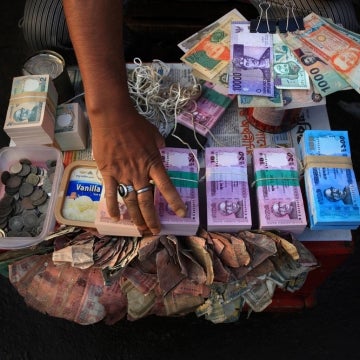In 2024, CGAP and MFR research explored trends and challenges in trying to close the gender gap for small borrowers, specifically examining how different institutional structures link to different outcomes. Smaller institutions, often organized as NGOs or providing group loans, such as cooperatives, demonstrated the best outcomes for women borrowers. However, even though they deliver for women, these institutions sail in hazardous financial waters – their operating expenses are generally higher, they have an over-reliance on donor funding, and they have limited opportunities for building important economies of scale. Moreover, as our latest research shows, they are very much at the mercy of foreign exchange (forex) risk.
This research is based on the ATLAS database, including 3,073 Financial Institutions in the Financial Inclusion sector with data available from 2015 to 2024, with the following distribution:
- Latin America and the Caribbean (35%), South and Southeast Asia (26%), Sub-Saharan Africa (23%), and Europe and Central Asia (16%).
- Small size – total assets 10M USD (39%), medium size – total assets 10-100M USD (34%), large size – total assets >100M USD (27%)
- Non-Bank Financial Institution (41%), Bank (23%), Cooperative (20%), NGO (16%)
Forex risk is an unpredictable force lurking below the surface of the financial sector. From large banks to small cooperatives, the ability to manage forex risk influences financial health, sustainability, and ultimately, the cost of borrowing for clients—especially women. While the data shows that overall access to local currency funding, including customer deposits, has begun to improve over time, significant regional disparities remain, especially with regard to unhedged open forex positions.
To promote financial inclusion and gender equity, donors and development finance institutions (DFIs) must prioritize expanding local currency funding, help strengthen risk management for smaller institutions, and provide funding structures that are able to directly address and mitigate forex risk.
The forex risk equation is a costly gamble
One of the most striking findings of the research underpinning this blog is the clear association between forex borrowing and financial strain. While forex funding offers institutions access to international capital, it can come at a price. Financial institutions that fail to hedge against forex risk and where local currencies depreciate face the higher local currency costs of servicing their forex obligations, and these costs are inevitably passed on to borrowers.
Latin America stands out as a leader in securing local currency funding (see above), having reduced its reliance on forex borrowing. In contrast, Sub-Saharan Africa faces the highest levels of unhedged forex exposure, putting institutions—and their borrowers—at risk. Asia presents a paradox: while attracting lower amounts of local currency funding, many financial institutions there have implemented relatively strong risk management measures, keeping forex exposure in check. Europe and Central Asia, meanwhile, exhibit moderate forex risk levels but demonstrate a higher adoption of hedging strategies. This regional variation underscores the importance of local financial ecosystems, and Latin America’s particular experience in developing mechanisms for the wholesaling of local currency finance to lenders that service small enterprises provides important lessons in this context.
Also revealed by the analysis, larger banks tend to manage forex risk reasonably well, leveraging their robust governance structures to hedge against currency swings. However, smaller institutions—especially cooperatives and non-bank financial institutions (NBFIs)—often lack the tools and expertise to hedge effectively. As a result, they face higher borrowing costs and increased financial vulnerability, as shown in Figure 2.
These costs add to the already high operational and other costs traditionally associated with the provision of small loans by MFIs and similar institutions, as Figure 3 below highlights.
The consequences? A greater likelihood of passing the costs of servicing foreign currency debt onto borrowers, many of whom are already financially marginalized.
The gendered impact: women borrowers pay the price
Perhaps the most concerning finding is the impact of forex risk on women borrowers. Institutions that primarily serve women—such as NGOs and NBFIs—rely on more expensive borrowed funds. With limited access to deposits or favourable local currency funding, these institutions have no option but to pass on, through higher interest rates, the associated costs of servicing forex loans to their clients, even though the loans they make are denominated in local currency.
Loan size further compounds this issue. Women borrowers typically receive smaller loans, which require higher portfolio yields to remain sustainable. Figure 4 above presents the % of female borrowers, grouped by financial institutions with higher and lower spreads, and loan sizes. Spread is calculated as the difference between the cost of borrowed funds/deposits for the financial institution and the domestic lending rate. A higher spread indicates that financial institutions are accessing funds at a higher cost relative to the domestic lending rate. These are the financial institutions that serve women the most, especially with lower loan sizes.
Figure 5 below breaks the data down by charter type (banks, cooperatives, NBFIs, etc.), and the picture is clear – the institutions that have smaller loan sizes have, across the board, significantly higher numbers of women borrowers. This means that even as financial institutions expand their outreach to women, the cost of borrowing will remain disproportionately high, especially in regions like Sub-Saharan Africa.
And we need to remember that forex risk and high funding costs are not just technical issues—they have a real impact on low-income borrowers. Without targeted measures to help address the forex/local currency issue and moves to improve access to lower-cost local currency funding to smaller impact-focused financial institutions, women borrowers will continue to be disadvantaged, and the brakes on their economic empowerment will remain in place.
What can be done?
For donors and development finance institutions (DFIs), these findings present evidence of the impact of forex risk on the costs that women borrowers face. Financial support needs to be structured to minimize forex risk and prioritize financial inclusion. There is significant attention being paid to this key issue currently, and additional detailed research is underway, most recently by the Universities of Leeds and Hertfordshire Business Schools, which explores ways in which DFIs can refocus their priorities. A number of actions are needed to ensure women do not pay the price of forex risk:
Promotion of local currency funding
Expanding access to local currency financing is critical. Donors, foundations, and DFIs should explore innovative ways to support institutions that provide finance to women, to reduce reliance on foreign borrowing and boost the supply of reasonably priced local currency finance. First loss risk mitigation instruments, funds that manage diverse portfolios of local currencies, cooperation with local tier one commercial banks that run treasuries able to partially self-hedge, and mechanisms that take on tail risk on currencies in return for participation in any upside, are all instruments that have the potential to be sustainable over the medium to long term.
Strengthen risk management for smaller institutions
Capacity-building initiatives should target smaller financial institutions, equipping them with the tools and knowledge to manage forex risk effectively. This includes technical assistance in hedging strategies, governance improvements, and risk management training.
Incentivize gender-sensitive financial policies
Given that institutions serving women face higher funding costs, donors should design funding mechanisms that specifically support these institutions. Blended finance approaches—where concessional capital can be used to lower borrowing costs for gender-focused institutions—could be a game-changer.
The story of forex funding is not just about exchange rates and financial mechanisms. It’s about equity, sustainability, and inclusion. The institutions that struggle the most with forex risk are often the ones that serve the most vulnerable borrowers. Addressing these challenges requires strategic intervention: more local currency funding, better forex risk management, and targeted support for institutions that serve women.



